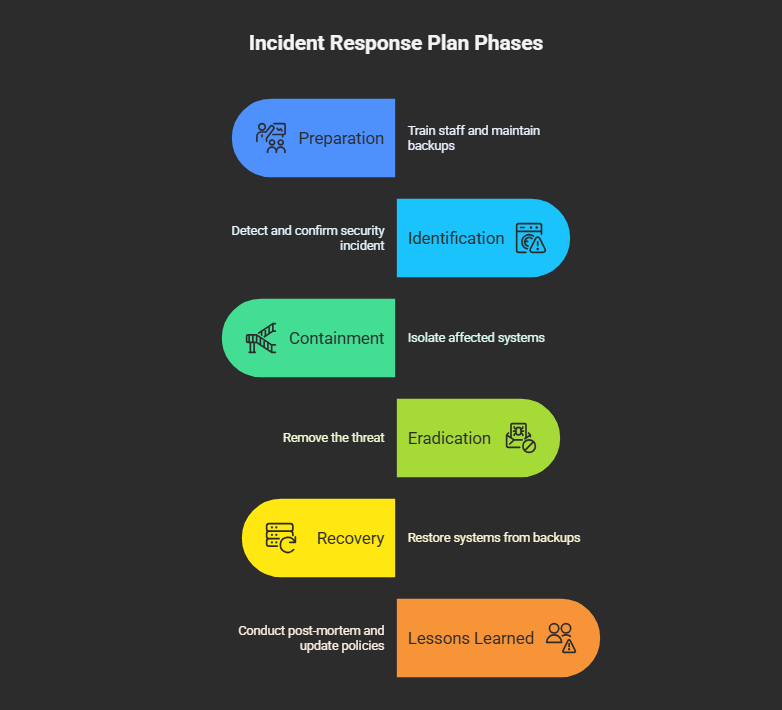Cybersecurity for Small Businesses: Tips to Stay Secure in 2025
- James McCarthy
- Mar 13
- 4 min read

Introduction
Cyber threats are evolving rapidly, and small businesses are increasingly becoming prime targets for cybercriminals. Without proper cybersecurity measures in place, your business could face data breaches, financial losses, and reputational damage. So, how can small businesses stay secure in 2025? In this post, we’ll cover essential cybersecurity strategies, emerging trends, and best practices to help safeguard your business in the coming years.
Why Is Cybersecurity Important for Small Businesses in 2025?
Many small business owners mistakenly believe that cybercriminals only target large corporations. However, small businesses often lack the resources and security infrastructure of larger companies, making them an easier target.
According to cybersecurity reports, nearly half of cyberattacks are aimed at small businesses. With new threats emerging, having a solid cybersecurity strategy is no longer optional—it’s essential.
How Can Small Businesses Strengthen Their Network Security?
A strong network security foundation is the first line of defense against cyber threats. Here’s what you need to do:
Invest in firewalls and intrusion detection systems – These tools help monitor and block unauthorized access to your network.
Use secure Wi-Fi networks – Ensure your business Wi-Fi is encrypted, has a strong password, and is separate from guest networks.
Limit access to sensitive information – Only grant permissions to employees who need them.
Implement Virtual Private Networks (VPNs) – A VPN encrypts internet traffic, protecting data when employees work remotely.
Learn more about safeguarding your business.
What Are the Benefits of Multi-Factor Authentication (MFA)?
Multi-Factor Authentication (MFA) is a simple yet effective way to enhance security. Instead of relying solely on passwords, MFA requires additional verification steps, such as a fingerprint scan or a one-time code sent to a mobile device.
Benefits of MFA include:
Preventing unauthorized access – Even if a password is stolen, an attacker cannot access an account without the second factor.
Reducing phishing risks – Hackers often steal passwords through phishing attacks, but MFA makes it harder to exploit stolen credentials.
Meeting compliance requirements – Many industries now require MFA to protect sensitive data.
How Important Are Regular Software Updates and Patch Management?
Hackers often exploit outdated software to gain access to systems. Regular updates ensure security vulnerabilities are patched before they can be used against you.
To keep your systems secure:
Enable automatic updates – This ensures your software and operating systems stay up to date.
Schedule regular patch management reviews – Have an IT team or provider check for new patches and apply them promptly.
Keep third-party applications updated – Cybercriminals often target outdated plugins and extensions in popular software.
How Can Employee Training Reduce Cybersecurity Risks?
Your employees are both your first line of defense and your biggest vulnerability when it comes to cybersecurity. Human error is a leading cause of security breaches, so training is crucial.
Key training topics should include:
Recognizing phishing emails and scams – Employees should be cautious of suspicious emails, links, and attachments.
Using strong passwords and password managers – Weak passwords make it easy for hackers to gain access.
Understanding data protection policies – Teach employees how to handle sensitive business information securely.
Secure remote work practices – Employees working remotely should use company-approved VPNs and avoid public Wi-Fi networks.
Learn More about employee training here.
What Emerging Cybersecurity Trends Will Impact Small Businesses in 2025?
Cybersecurity is an ever-evolving field, and staying ahead of trends can give your business a competitive advantage.
AI and Machine Learning in Threat Detection – AI-driven security tools analyze network activity in real time and detect anomalies before they become full-blown attacks.
Cloud Security Innovations – With more businesses relying on cloud storage, expect to see enhanced encryption methods and AI-powered security monitoring.
Zero Trust Security Models – This approach assumes that no one inside or outside the network is automatically trusted, requiring strict verification for every user and device.
Ransomware Protection Improvements – New tools are emerging to detect and neutralize ransomware before it locks down data.
How Can Small Businesses Monitor Their Cybersecurity and Respond to Threats?
Ongoing monitoring and a solid incident response plan are crucial to mitigating cyber threats before they escalate.
Set up 24/7 monitoring tools – Automated security monitoring tools can detect unusual activity and flag potential threats.
Develop an incident response plan – Clearly define steps to take when a cyberattack occurs, including how to isolate threats and communicate with stakeholders.
Regularly review security logs – Keep track of login attempts, data access logs, and firewall reports to identify suspicious behavior.
Hire a managed security provider – If you lack an in-house cybersecurity team, a managed service provider can offer expert monitoring and support.
Why Is Data Backup and Recovery Planning Essential?
Even with the best security measures, breaches and data loss can still happen. A robust data backup and recovery strategy ensures that your business can recover quickly from a cyberattack or system failure.
Best practices include:
Regularly backing up data – Use both cloud and offline backups to prevent data loss.
Testing backup systems – Periodically verify that backups are functional and up-to-date.
Implementing redundancy measures – Store backup data in multiple locations to protect against natural disasters and cyber threats.
Conclusion
Cybersecurity is not a one-time task—it’s an ongoing process. Small businesses must be proactive in implementing security measures, staying informed about emerging threats, and educating employees on best practices. By strengthening your network, using MFA, keeping software updated, and investing in AI-driven security solutions, you can significantly reduce the risk of cyberattacks.
As we move into 2025, cybersecurity should be a top priority for small businesses looking to protect their assets, maintain customer trust, and stay ahead of cyber threats. Start implementing these strategies today to safeguard your business for the future.




Comments